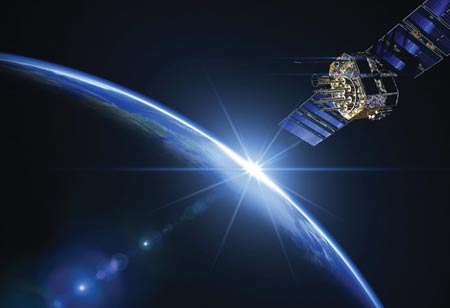

I agree We use cookies on this website to enhance your user experience. By clicking any link on this page you are giving your consent for us to set cookies. More info
Thank you for Subscribing to Business Management Review Weekly Brief

Iddo Salton is the VP of Innovation, Data & AI at Delek US. He has over 20 years of experience leading high-impact technology and data-driven initiatives. With a background in satellites, remote sensing, and AI, he specializes in driving operational efficiency and integrating complex systems across global industries, particularly within the U.S. energy sector. Through this article, Salton highlights how advanced data and AI technologies can drive operational efficiency and innovation across complex, high-risk industries.
Over the past two decades, the remote sensing landscape has undergone a dramatic transformation. What was once the exclusive domain of national governments and space agencies is now rapidly accessible to private enterprises, startups, and academic institutions. This shift, often called the “New Space” era, is characterized by plummeting costs in satellite manufacturing and launch services. Small satellites, offering surprisingly near real-time capabilities, high resolution and precision, can now be deployed for a fraction of the cost once required.
At the same time, drone technology has matured at an impressive pace. Affordable, agile, and easy to deploy, drones have added a dynamic layer to Earth observation capabilities. When used in conjunction with satellite imagery, they allow enterprises to gain insights that are timely, accurate and deeply contextualized.
Drones and Satellites: Complementary, Not Competing
The synergy between drones and satellites lies in their complementary strengths. Satellites provide broad, scalable coverage ideal for regional or global monitoring, with high geospatial precision and accurate mapping infrastructure, but often with limited temporal resolution due to their orbital paths. Drones, on the other hand, offer hyper-local, on-demand coverage and can capture data in specific spectrums at ultra-high resolution.
In one energy infrastructure project I led, satellite data provided early warning of subsidence in a pipeline corridor. But it was drone imagery, with centimeter-level resolution and thermal sensors, that allowed the team to pinpoint the location of stress points and deploy targeted maintenance, which saved both time and cost.
Fusing Spectral Bands for Greater Insight Empowered by AI
A key development in modern remote sensing is the fusion of different data sources and spectral bands: optical (RGB), thermal (IR), synthetic aperture radar (SAR), light detection and ranging (LIDAR), and hyperspectral (HRS) imaging. Each spectrum offers unique insights SAR for detecting minimal changes regardless of weather, IR for heat mapping, and hyperspectral for identifying materials, water and vegetation health.
Raw imagery is only the beginning. The real value lies in transforming that data into actionable insights. AI and ML have revolutionized this process and can provide additional insights like trend identification, anomaly and change detection
By fusing these data sources, organizations can unlock a holistic view of their assets or environment, especially from satellite and drone platforms. AI plays a critical role here in processing vast amounts of imagery and identifying patterns and anomalies that the human eye might miss.
The Role of AI in Turning Data into Action
Raw imagery is only the beginning. The real value lies in transforming that data into actionable insights. AI and ML have revolutionized this process and can provide additional insights like trend identification, anomaly and change detection. Models trained on massive datasets can now detect crop stress, monitor construction progress, assess disaster damage, or track environmental changes with remarkable accuracy and speed.
For example, in the aftermath of a hurricane, we leveraged satellite SAR data to assess flooded regions, while drones provided real-time visuals of the affected infrastructure. AI models stitched and analyzed both datasets to prioritize emergency responses within hours rather than days.
High Resolution and Geospatial Accuracy Matter
The quality of insights from remote sensing is only as good as the resolution and pointing accuracy of the data and mapping infrastructure (like orthophoto, 3D models and more). In many industrial applications, such as oil and gas, agriculture, defense, and smart cities, sub-meter resolution is critical. Furthermore, precise geospatial accuracy ensures that insights can be confidently acted upon, whether directing a maintenance crew or monitoring compliance on construction sites.
This emphasis on resolution and accuracy also guides the decision of when to deploy drones versus relying on satellite assets. It’s not a question of one over the other, but rather of selecting the right tool for the right objective.
From Defense to Commercial: Expanding Use Cases
While defense and intelligence sectors were the earliest adopters of high-resolution remote sensing, commercial sectors now embrace these tools en masse. Utilities are monitoring power lines, insurers are verifying claims, and cities are mapping urban growth – all using a mix of satellite and drone data.
In my experience, the most successful implementations involve cross-functional collaboration: data scientists, field engineers, AI experts, and business analysts working together to turn pixels into intelligence, insights & progress.
The Future: Accessible, Smart, and Real-Time
As satellite and drone technologies evolve and become more cost-effective, we’re approaching a future where real-time, intelligent Earth observation becomes a standard business tool. Democratization, better phrased as the broad accessibility of remote sensing, empowers not just large corporations, but small businesses, municipalities, and nonprofits to make data-driven decisions.
The fusion of AI, multi-spectral imagery, and integrated drone-satellite workflows is no longer a vision of the future, it’s a powerful capability available today for those ready to embrace it.